fuses SUBARU OUTBACK 2017 6.G Owners Manual
[x] Cancel search | Manufacturer: SUBARU, Model Year: 2017, Model line: OUTBACK, Model: SUBARU OUTBACK 2017 6.GPages: 610, PDF Size: 10.28 MB
Page 381 of 610
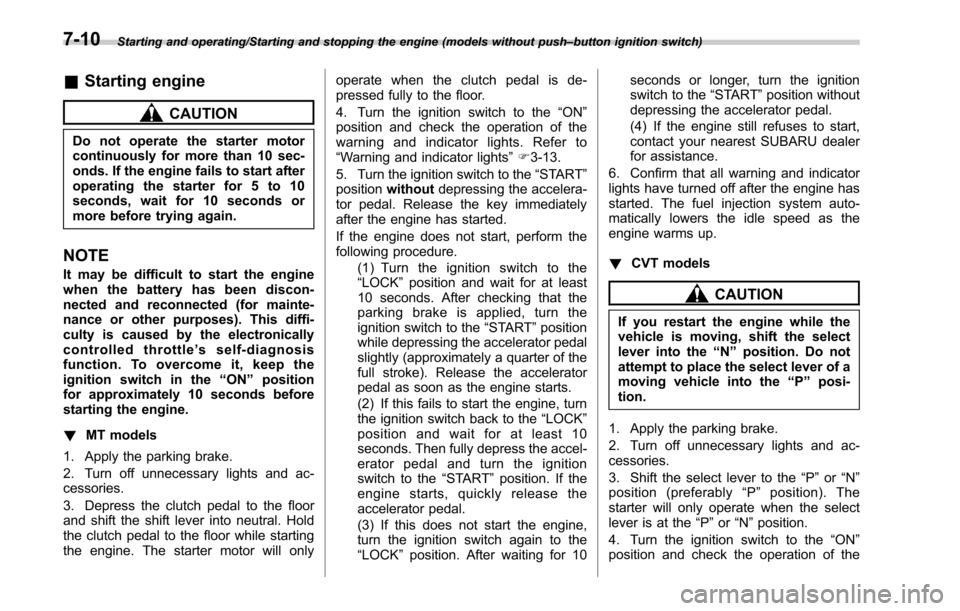
Starting and operating/Starting and stopping the engine (models without push–button ignition switch)
& Starting engine
CAUTION
Do not operate the starter motor
continuously for more than 10 sec-
onds. If the engine fails to start after
operating the starter for 5 to 10
seconds, wait for 10 seconds or
more before trying again.
NOTE
It may be difficult to start the engine
when the battery has been discon-
nected and reconnected (for mainte-
nance or other purposes). This diffi-
culty is caused by the electronically
controlled throttle ’s self-diagnosis
function. To overcome it, keep the
ignition switch in the “ON ”position
for approximately 10 seconds before
starting the engine.
! MT models
1. Apply the parking brake.
2. Turn off unnecessary lights and ac-
cessories.
3. Depress the clutch pedal to the floor
and shift the shift lever into neutral. Hold
the clutch pedal to the floor while starting
the engine. The starter motor will only operate when the clutch pedal is de-
pressed fully to the floor.
4. Turn the ignition switch to the
“ON”
position and check the operation of the
warning and indicator lights. Refer to
“ Warning and indicator lights ”F 3-13.
5. Turn the ignition switch to the “START”
position without depressing the accelera-
tor pedal. Release the key immediately
after the engine has started.
If the engine does not start, perform the
following procedure.
(1) Turn the ignition switch to the
“LOCK” position and wait for at least
10 seconds. After checking that the
parking brake is applied, turn the
ignition switch to the “START”position
while depressing the accelerator pedal
slightly (approximately a quarter of the
full stroke). Release the accelerator
pedal as soon as the engine starts.
(2) If this fails to start the engine, turn
the ignition switch back to the “LOCK”
position and wait for at least 10
seconds. Then fully depress the accel-
erator pedal and turn the ignition
switch to the “START”position. If the
engine starts, quickly release the
accelerator pedal.
(3) If this does not start the engine,
turn the ignition switch again to the
“ LOCK” position. After waiting for 10 seconds or longer, turn the ignition
switch to the
“START”position without
depressing the accelerator pedal.
(4) If the engine still refuses to start,
contact your nearest SUBARU dealer
for assistance.
6. Confirm that all warning and indicator
lights have turned off after the engine has
started. The fuel injection system auto-
matically lowers the idle speed as the
engine warms up.
! CVT models
CAUTION
If you restart the engine while the
vehicle is moving, shift the select
lever into the “N ” position. Do not
attempt to place the select lever of a
moving vehicle into the “P ” posi-
tion.
1. Apply the parking brake.
2. Turn off unnecessary lights and ac-
cessories.
3. Shift the select lever to the “P”or “N”
position (preferably “P ” position). The
starter will only operate when the select
lever is at the “P”or “N”position.
4. Turn the ignition switch to the “ON”
position and check the operation of the
7-10
Page 505 of 610
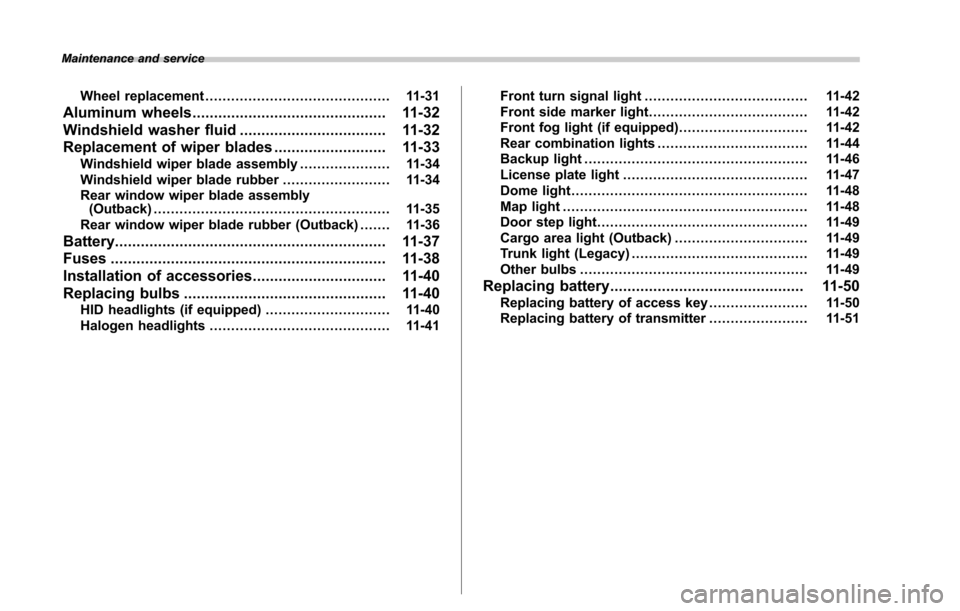
Maintenance and service
Wheel replacement........................................... 11-31
Aluminum wheels............................................. 11-32
Windshield washer fluid .................................. 11-32
Replacement of wiper blades .......................... 11-33
Windshield wiper blade assembly ..................... 11-34
Windshield wiper blade rubber ......................... 11-34
Rear window wiper blade assembly (Outback) ....................................................... 11-35
Rear window wiper blade rubber (Outback) ... .... 11-36
Battery............................................................... 11-37
Fuses ................................................................ 11-38
Installation of accessories ............................... 11-40
Replacing bulbs ............................................... 11-40
HID headlights (if equipped) ............................. 11-40
Halogen headlights .......................................... 11-41 Front turn signal light
...................................... 11-42
Front side marker light ..................................... 11-42
Front fog light (if equipped) .............................. 11-42
Rear combination lights ................................... 11-44
Backup light .................................................... 11-46
License plate light ........................................... 11-47
Dome light ....................................................... 11-48
Map light ......................................................... 11-48
Door step light ................................................. 11-49
Cargo area light (Outback) ............................... 11-49
Trunk light (Legacy) ......................................... 11-49
Other bulbs ..................................................... 11-49
Replacing battery ............................................. 11-50Replacing battery of access key ....................... 11-50
Replacing battery of transmitter ....................... 11-51
Page 517 of 610
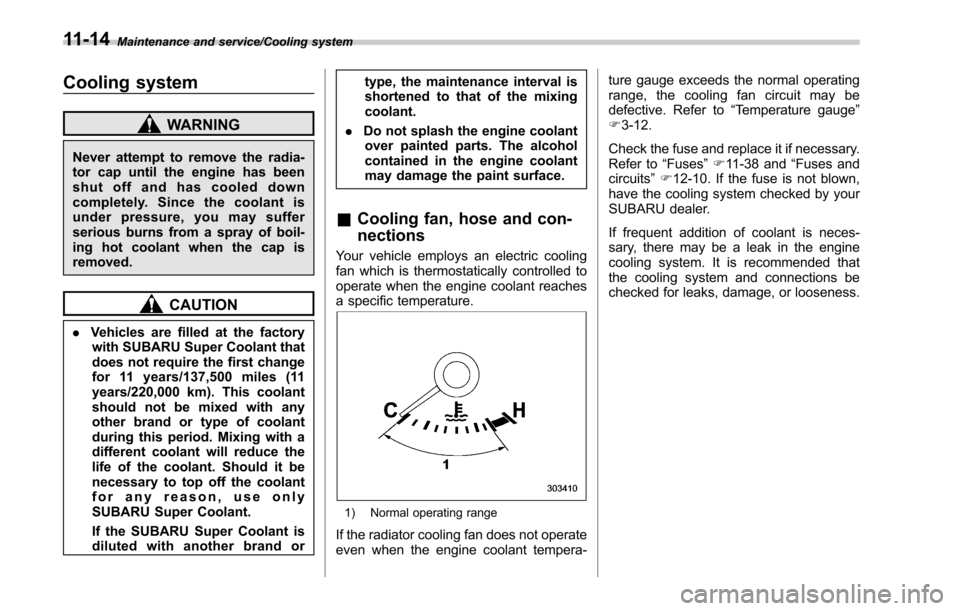
Maintenance and service/Cooling system
Cooling system
WARNING
Never attempt to remove the radia-
tor cap until the engine has been
shut off and has cooled down
completely. Since the coolant is
under pressure, you may suffer
serious burns from a spray of boil-
ing hot coolant when the cap is
removed.
CAUTION
.Vehicles are filled at the factory
with SUBARU Super Coolant that
does not require the first change
for 11 years/137,500 miles (11
years/220,000 km). This coolant
should not be mixed with any
other brand or type of coolant
during this period. Mixing with a
different coolant will reduce the
life of the coolant. Should it be
necessary to top off the coolant
for any reason, use only
SUBARU Super Coolant.
If the SUBARU Super Coolant is
diluted with another brand or type, the maintenance interval is
shortened to that of the mixing
coolant.
. Do not splash the engine coolant
over painted parts. The alcohol
contained in the engine coolant
may damage the paint surface.
& Cooling fan, hose and con-
nections
Your vehicle employs an electric cooling
fan which is thermostatically controlled to
operate when the engine coolant reaches
a specific temperature.
1) Normal operating range
If the radiator cooling fan does not operate
even when the engine coolant tempera- ture gauge exceeds the normal operating
range, the cooling fan circuit may be
defective. Refer to
“Temperature gauge ”
F 3-12.
Check the fuse and replace it if necessary.
Refer to “Fuses”F 11-38 and “Fuses and
circuits ”F 12-10. If the fuse is not blown,
have the cooling system checked by your
SUBARU dealer.
If frequent addition of coolant is neces-
sary, there may be a leak in the engine
cooling system. It is recommended that
the cooling system and connections be
checked for leaks, damage, or looseness.
11-14
Page 541 of 610
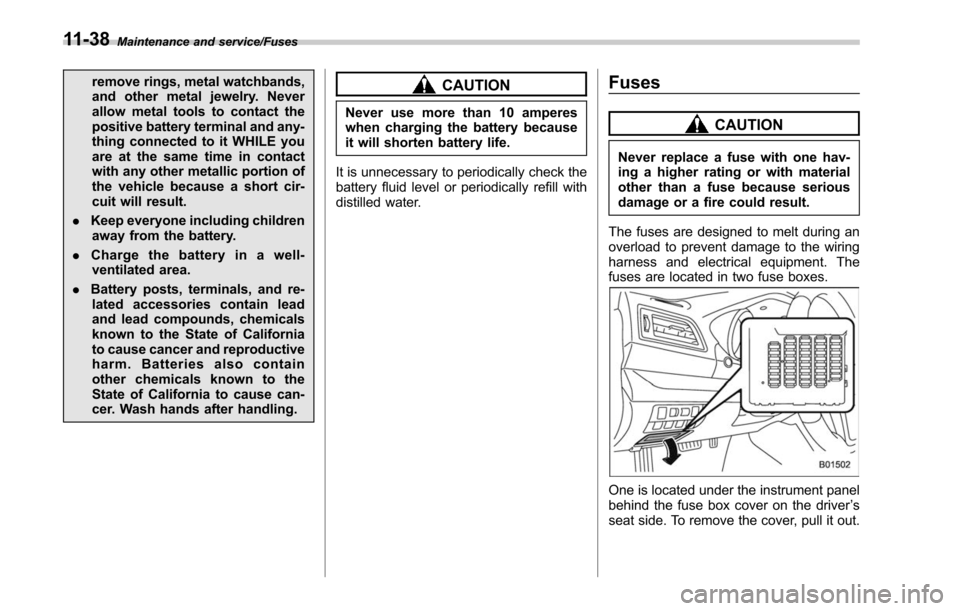
Maintenance and service/Fuses
remove rings, metal watchbands,
and other metal jewelry. Never
allow metal tools to contact the
positive battery terminal and any-
thing connected to it WHILE you
are at the same time in contact
with any other metallic portion of
the vehicle because a short cir-
cuit will result.
. Keep everyone including children
away from the battery.
. Charge the battery in a well-
ventilated area.
. Battery posts, terminals, and re-
lated accessories contain lead
and lead compounds, chemicals
known to the State of California
to cause cancer and reproductive
harm. Batteries also contain
other chemicals known to the
State of California to cause can-
cer. Wash hands after handling.CAUTION
Never use more than 10 amperes
when charging the battery because
it will shorten battery life.
It is unnecessary to periodically check the
battery fluid level or periodically refill with
distilled water.
Fuses
CAUTION
Never replace a fuse with one hav-
ing a higher rating or with material
other than a fuse because serious
damage or a fire could result.
The fuses are designed to melt during an
overload to prevent damage to the wiring
harness and electrical equipment. The
fuses are located in two fuse boxes.
One is located under the instrument panel
behind the fuse box cover on the driver ’s
seat side. To remove the cover, pull it out.
11-38
Page 542 of 610
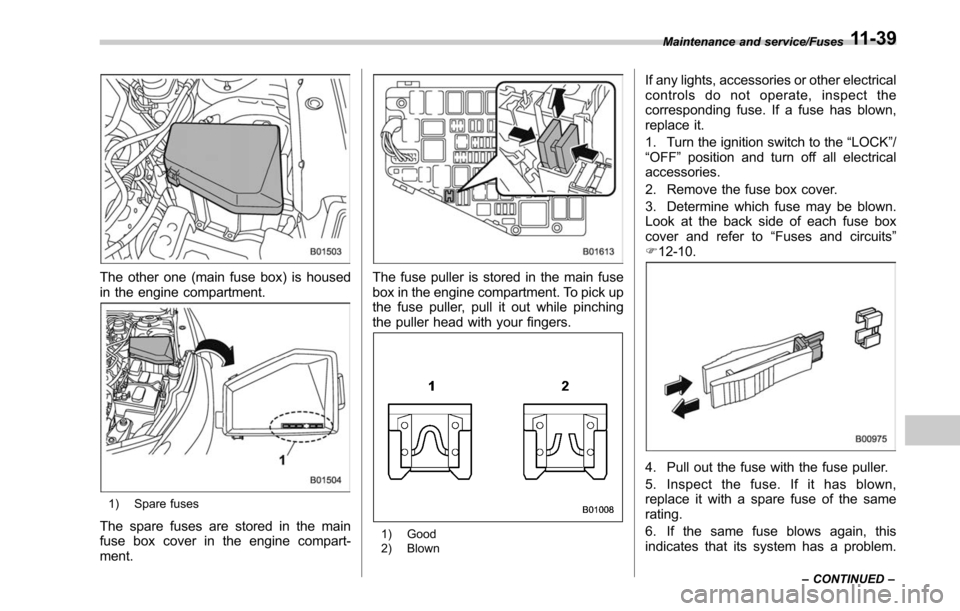
The other one (main fuse box) is housed
in the engine compartment.
1) Spare fuses
The spare fuses are stored in the main
fuse box cover in the engine compart-
ment.
The fuse puller is stored in the main fuse
box in the engine compartment. To pick up
the fuse puller, pull it out while pinching
the puller head with your fingers.
1) Good
2) Blown
If any lights, accessories or other electrical
controls do not operate, inspect the
corresponding fuse. If a fuse has blown,
replace it.
1. Turn the ignition switch to the“LOCK”/
“OFF ”position and turn off all electrical
accessories.
2. Remove the fuse box cover.
3. Determine which fuse may be blown.
Look at the back side of each fuse box
cover and refer to “Fuses and circuits”
F 12-10.
4. Pull out the fuse with the fuse puller.
5. Inspect the fuse. If it has blown,
replace it with a spare fuse of the same
rating.
6. If the same fuse blows again, this
indicates that its system has a problem.
Maintenance and service/Fuses
–CONTINUED –11-39
Page 556 of 610
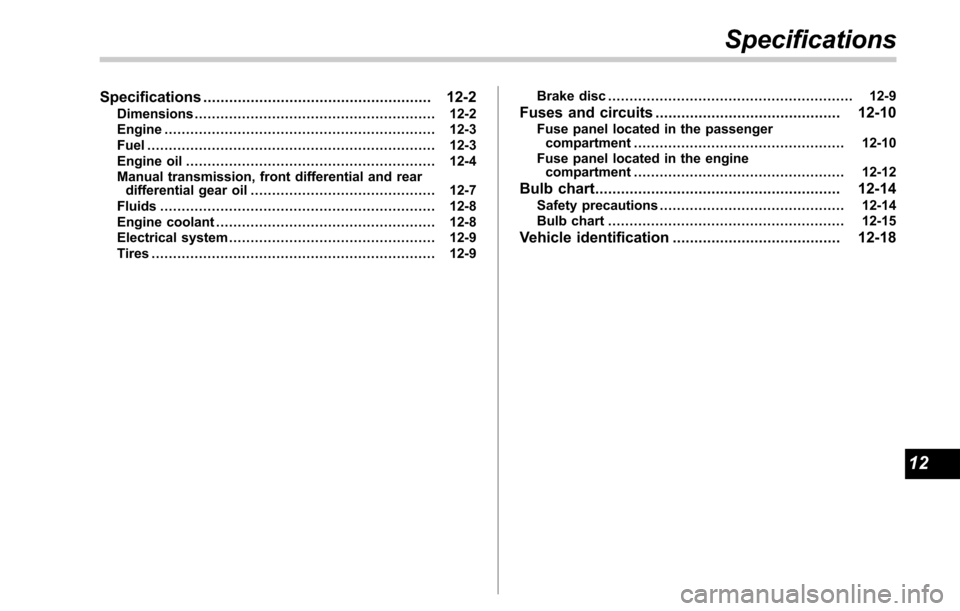
Specifications..................................................... 12-2
Dimensions........................................................ 12-2
Engine ............................................................... 12-3
Fuel ................................................................... 12-3
Engine oil .......................................................... 12-4
Manual transmission, front differential and rear differential gear oil ........................................... 12-7
Fluids ................................................................ 12-8
Engine coolant ................................................... 12-8
Electrical system ................................................ 12-9
Tires .................................................................. 12-9 Brake disc
......................................................... 12-9Fuses and circuits ........................................... 12-10
Fuse panel located in the passenger
compartment ................................................. 12-10
Fuse panel located in the engine compartment ................................................. 12-12
Bulb chart......................................................... 12-14Safety precautions ........................................... 12-14
Bulb chart ....................................................... 12-15
Vehicle identification ....................................... 12-18
Specifications
12
Page 565 of 610
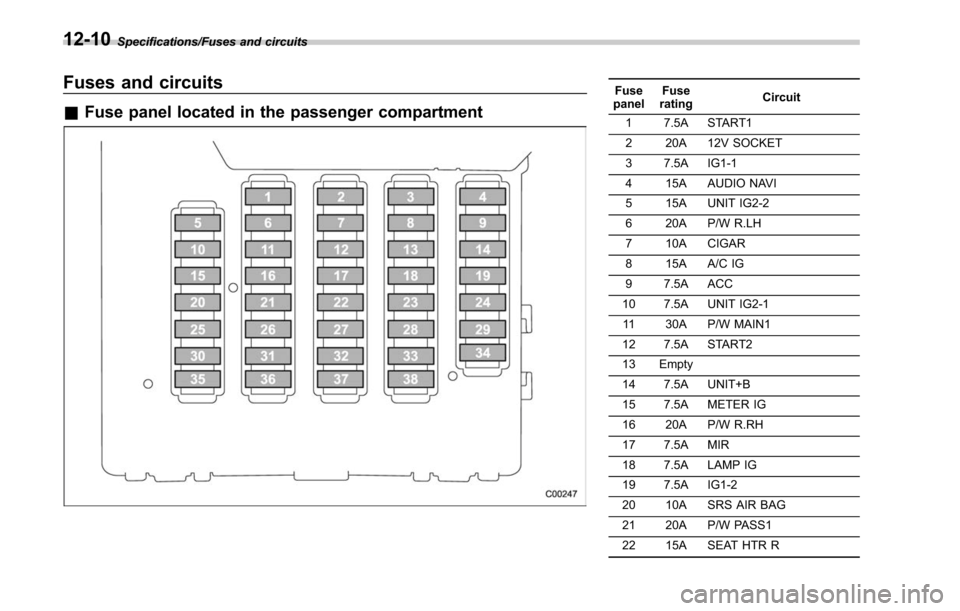
Specifications/Fuses and circuits
Fuses and circuits
&Fuse panel located in the passenger compartment
Fuse
panel Fuse
rating Circuit
1 7.5A START1
2 20A 12V SOCKET
3 7.5A IG1-1
4 15A AUDIO NAVI
5 15A UNIT IG2-2
6 20A P/W R.LH
7 10A CIGAR
8 15A A/C IG
9 7.5A ACC
10 7.5A UNIT IG2-1
11 30A P/W MAIN1
12 7.5A START2
13 Empty
14 7.5A UNIT+B
15 7.5A METER IG
16 20A P/W R.RH
17 7.5A MIR
18 7.5A LAMP IG
19 7.5A IG1-2
20 10A SRS AIR BAG
21 20A P/W PASS1
22 15A SEAT HTR R
12-10
Page 566 of 610
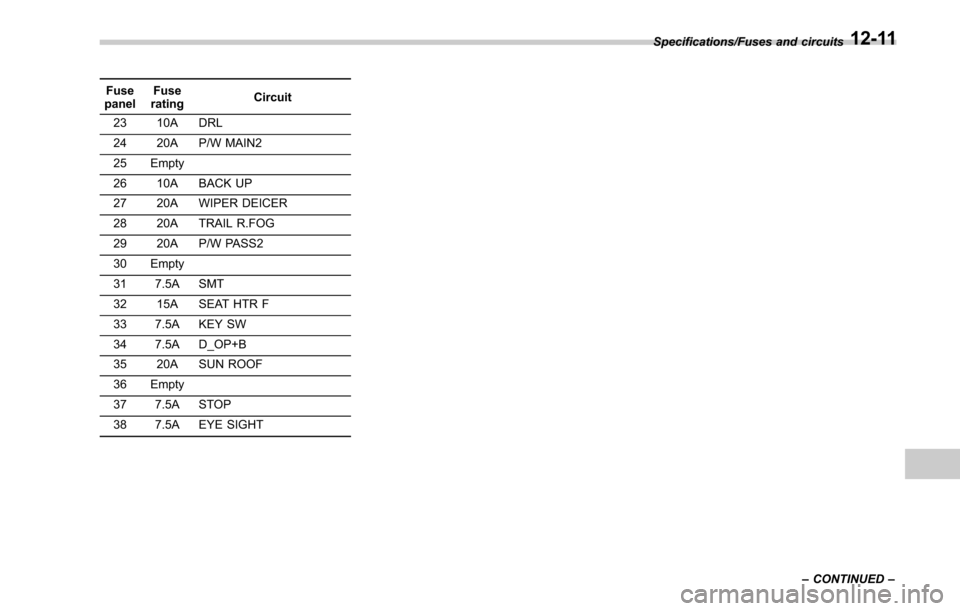
Fuse
panel Fuse
rating Circuit
23 10A DRL
24 20A P/W MAIN2
25 Empty
26 10A BACK UP
27 20A WIPER DEICER
28 20A TRAIL R.FOG
29 20A P/W PASS2
30 Empty
31 7.5A SMT
32 15A SEAT HTR F
33 7.5A KEY SW
34 7.5A D_OP+B
35 20A SUN ROOF
36 Empty
37 7.5A STOP
38 7.5A EYE SIGHT Specifications/Fuses and circuits
–CONTINUED –
12-11
Page 567 of 610
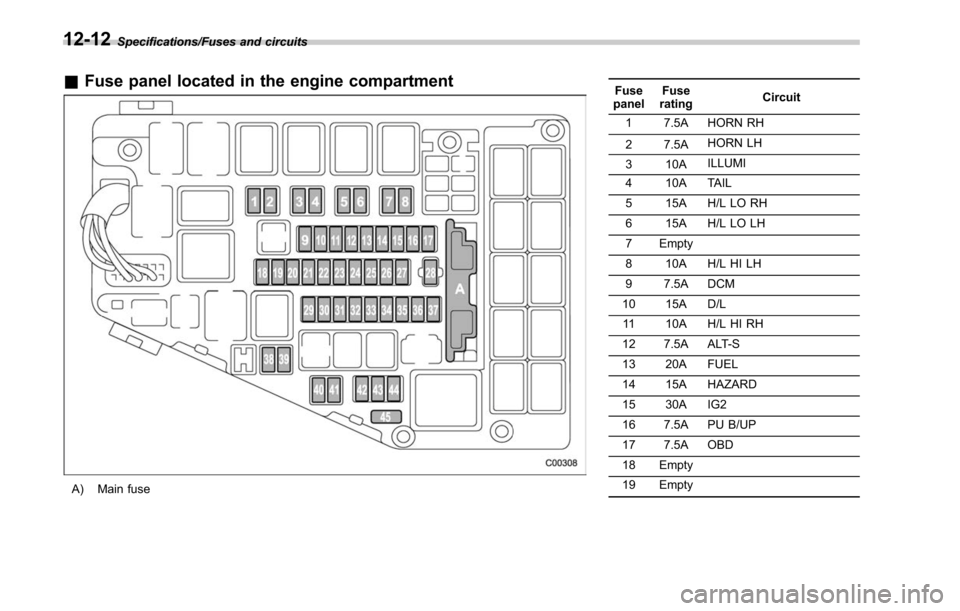
Specifications/Fuses and circuits
&Fuse panel located in the engine compartment
A) Main fuse Fuse
panel Fuse
rating Circuit
1 7.5A HORN RH
2 7.5A HORN LH
3 10A ILLUMI
4 10A TAIL
5 15A H/L LO RH
6 15A H/L LO LH
7 Empty
8 10A H/L HI LH
9 7.5A DCM
10 15A D/L
11 10A H/L HI RH
12 7.5A ALT-S
13 20A FUEL
14 15A HAZARD
15 30A IG2
16 7.5A PU B/UP
17 7.5A OBD
18 Empty
19 Empty
12-12
Page 568 of 610
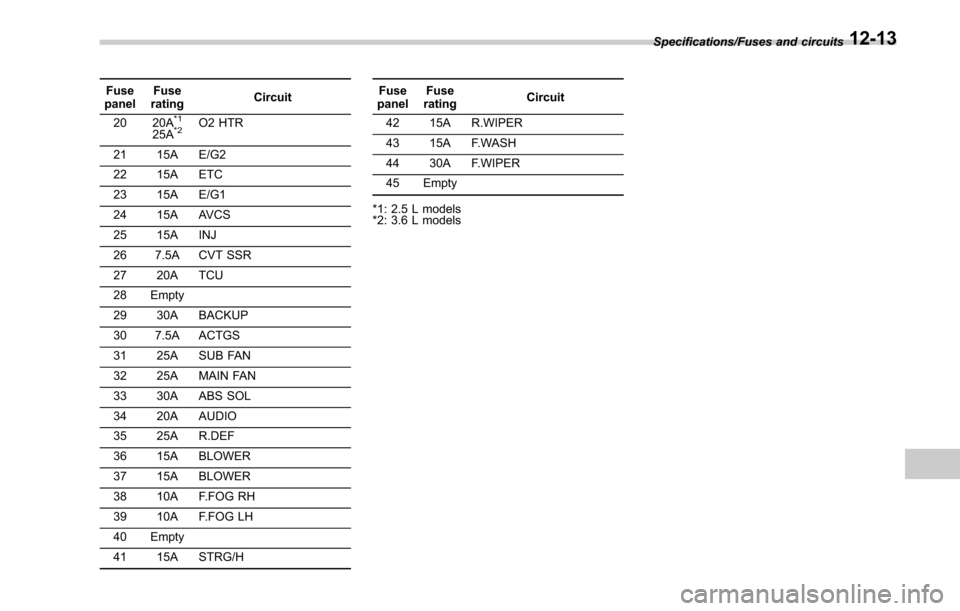
Fuse
panel Fuse
rating Circuit
20 20A
*1
25A*2O2 HTR
21 15A E/G2
22 15A ETC
23 15A E/G1
24 15A AVCS
25 15A INJ
26 7.5A CVT SSR
27 20A TCU
28 Empty
29 30A BACKUP
30 7.5A ACTGS
31 25A SUB FAN
32 25A MAIN FAN
33 30A ABS SOL
34 20A AUDIO
35 25A R.DEF
36 15A BLOWER
37 15A BLOWER
38 10A F.FOG RH
39 10A F.FOG LH
40 Empty
41 15A STRG/H Fuse
panel Fuse
rating Circuit
42 15A R.WIPER
43 15A F.WASH
44 30A F.WIPER
45 Empty
*1: 2.5 L models
*2: 3.6 L models Specifications/Fuses and circuits
12-13